Of Tomistoma and Taxonomy ...
Of Tomistoma and Taxonomy ...
There is something strange about the way some creatures seem to court controversy for no apparent rhyme or reason. And there are those for whom controversy is a birthright. I think that taxonomists ought to categorically be classified under the latter set. The irony of this classification should not be missed. Please do not take me wrong, I have immense admiration for Linnaeus and his Systema Naturae; his academic descendants, however, are a mixed lot and can on occasion give one the heebie-jeebies. Take the class Aves, for instance. Some warblers, pipits, and larks have me tearing my hair apart, only to be topped off with random changes in nomenclature ever so often based on some obscure physical characteristic. Unfortunately, the Tomistoma or False Gharial is hounded by both controversy and taxonomists, for no apparent fault of its own.
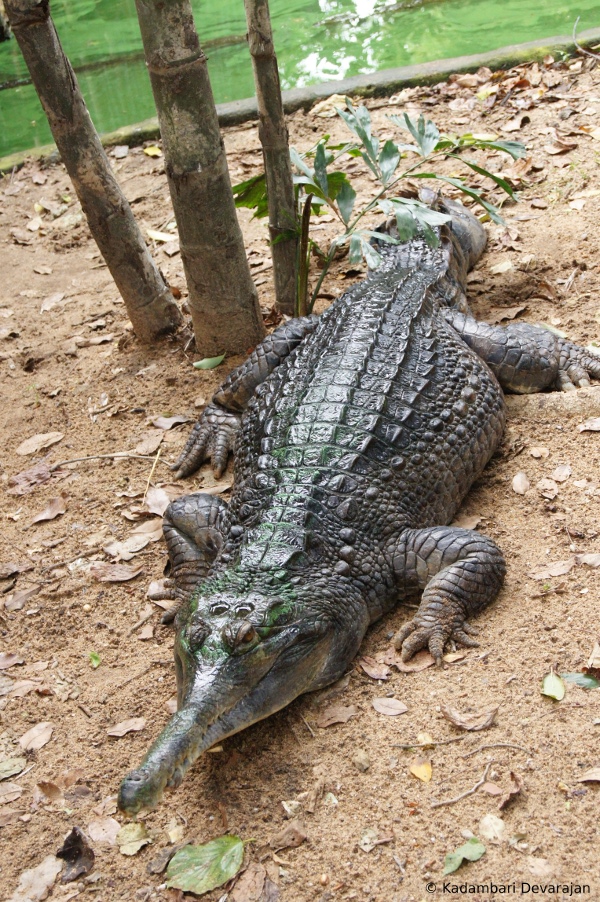
For those who need an introduction to the Tomistoma, here goes. The False Gharial (scientific name: Tomistoma schlegelii) is a large freshwater crocodilian found in parts of South-east Asia. After being declared 'regionally extinct' in Thailand, its current range comprises of Indonesia and Malaysia, with unconfirmed reports from Vietnam. It is considered to be endangered with estimated populations in the wild said to be under 2500 individuals (as of the year 2000), and is on the IUCN Red List as well as Appendix I of CITES. The Tomistoma Task Force (TTF) was set up in 2003 in the hope of saving the Tomistoma from imminent extinction. Traditionally, it had been placed under the family Crocodylidae based on morphological characteristics. Recent immunological research seems to indicate affinity to the family Gavialidae and its classification seems to be a topic of current hot debate amongst taxonomists, resulting in it being addressed as 'Tomistoma' rather than 'False Gharial' so as to mitigate confusion.
The Tomistoma gets its common name from its snout which resembles the narrow snout of the Gharial (scientific name: Gavialis gangeticus), while its scientific name stands for 'sharp mouth' (Greek: 'tomos'-'sharp', 'stoma'-'mouth') referring to its slender snout. Recent research shows that, unlike the gharial, the Tomistoma not only feeds on fish and invertebrates but small mammals and other reptiles as well, mostly thanks to its broader snout. They are 'mound-nesters' and their eggs are said to be amongst the largest in size of those laid by extant crocodilians. Unlike most other crocodilians, the young of the Tomistoma are said to receive little or no parental care. Studies on Tomistoma, both in the wild and in captivity, are few and far, with research picking up only in recent years especially after the TTF came into existence. The only pair of Tomistoma in India can be found at the Madras Crocodile Bank Trust (MCBT) and Center for Herpetology near Chennai.
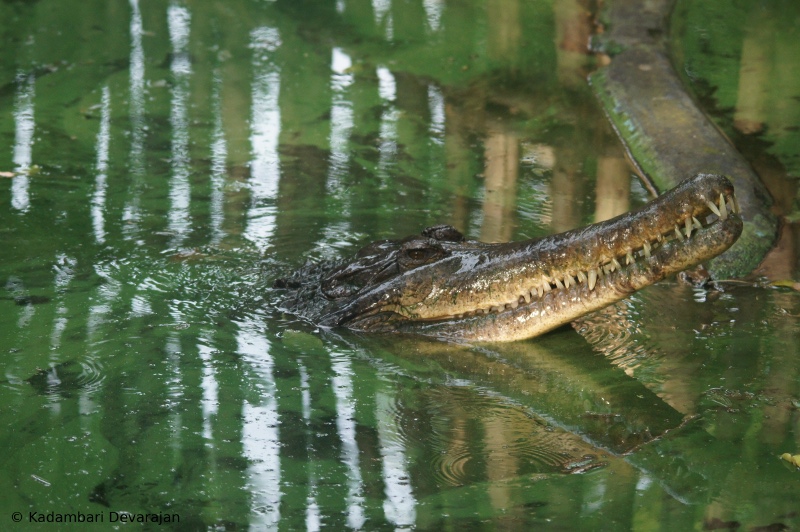
When I landed up at the Croc Bank a few months ago hoping to learn all I could about reptiles and their conservation, I had barely heard of the Tomistoma. What little I knew actually stemmed from some homework I was doing before a whirlwind (but productive) birdwatching trip around SE Asia last summer. While I ended up managing to see more than just birds, the only crocodilian that I saw in the region was an Estuarine (Saltie!) Crocodile in Sungei Buloh, albeit being knee-deep in Tomistoma territory in Malaysia and Indonesia much to my (later) chagrin. Basically, I had no preference or favorites as far as studying crocs in captivity went when I entered the gates of MCBT. And it was not love at first sight for me when folks there asked me if I would be interested in studying the Tomistoma day and night to see if captive breeding was a feasible option. It was one of those, 'Whatever' moments, if you will. Thus began my introduction to Psycho and Godzilla, the Tomistoma couple-of-the-century-hopefuls at Croc Bank. And so for almost two months I took notes on them during their 'courtship'. Psycho is the apparently 'psychotic' (certainly not 'psychic', as someone let slip!) male who was actually extremely well behaved during my watch and made me question the psyche of whoever named him! Godzilla is the feisty and temperamental female. On a one-off moment when I was feeling a tad maternal towards her, I politely asked the powers that be, 'Why Godzilla? For a name, I mean ... Can we give her another name?' and the look of pure derision that I received ensured that I never broached the subject again.
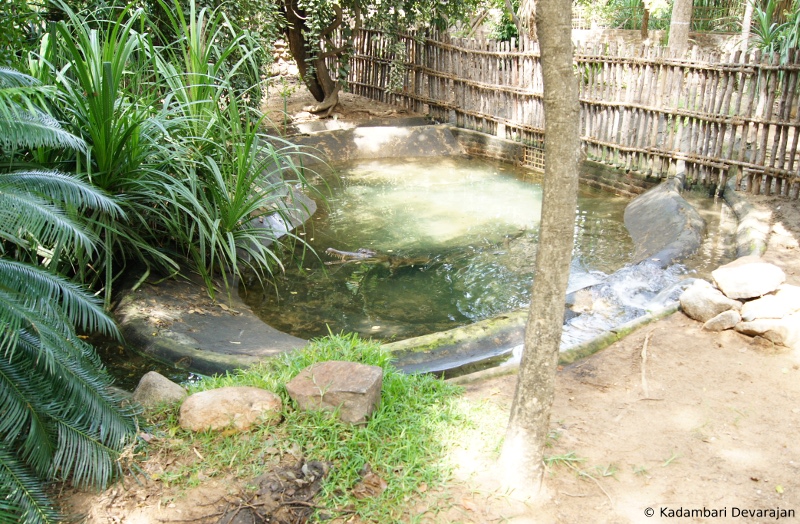
The captive breeding of crocodiles is always a hit-or-miss situation with erratic crocodilian tempers and other reasons beyond human comprehension coming into the equation. Unpredictability is the order of the day and a happy love-story one day might have a gory ending with the usually smaller female being ripped to shreds the next. With them being India's only hopes at seeing a Tomistoma baby anytime soon, nobody was willing to risk losing either of the potential parents. Understandably, MCBT wanted to stretch the 'holding hands' period and test the waters for at least basic compatibility. To aid them, a rather effective barrier was constructed along the pond and the enclosure was divided into two. The barrier was essentially just a fence of bamboo poles jutting out for about 2m above water, and a solid brick-and-cement divider of the pond underwater. The beauty of this ingenious system was that they could still see and smell each other, i.e., the barrier was just physical and not visual. They had this one favorite spot where the gap between two of the poles had been widened just enough to let them 'touch snouts'. And much to everybody's collective pride, they had managed this themselves and went on to establish a few more such 'love seats'. One could not but help going 'Awwwww' at them basking peacefully, apparently oblivious to everything else, with their snouts touching intimately (please excuse all the blatant anthropomorphizing of things)!
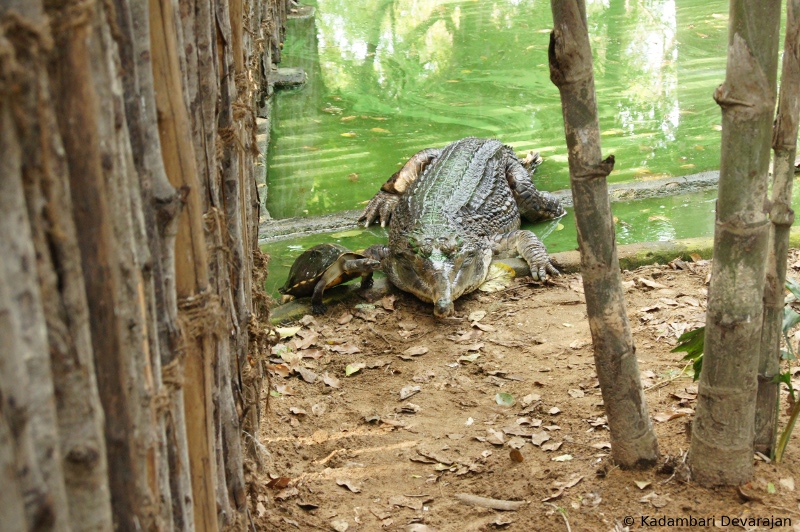
My responsibility was to periodically monitor them, roughly every 2 hours everyday and take notes on their position, behavior, environmental conditions, etc. Some days would be especially dull and monotonous with them not even budging an inch from wherever they were. These would often be interspersed with events that generate some excitement. Psycho is quite the performer and would always play to the audience. If there is a noisy crowd around, one could always expect him to come by and make loud noises. He would occasionally thrash his tail in the water, just lift it up once and bring it crashing down on the water, wiggle his tummy, or make gurgling noises underwater, sometimes with visible ripples. Godzilla was usually quiet and if anything would vent her anger on the turtles in the pond. She would either bask quietly on the mound at the back of the enclosure or lie still in water, sometimes barely visible. 'Feeding day' would elicit the maximum excitement with both of them feeding alongside, but for the barrier. Somehow the turtles would start teeming around Godzilla and only the brave few would dare grab their share around Psycho.
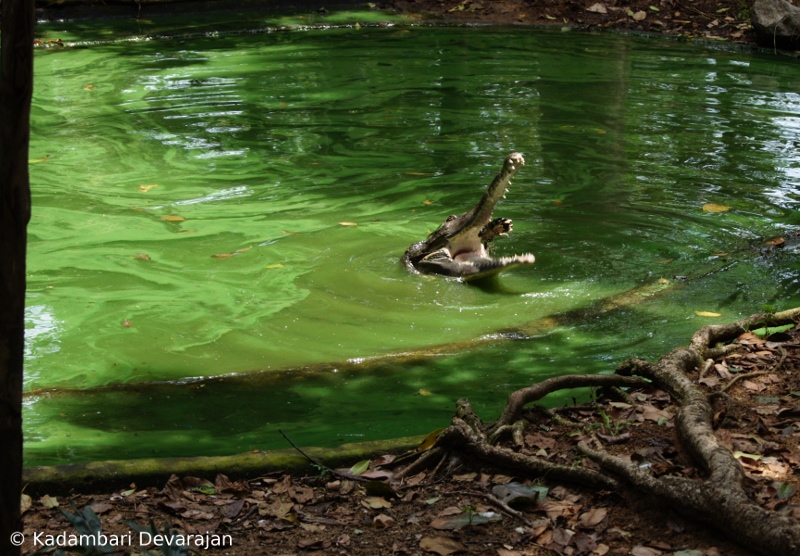
One of the most interesting incidents that happened when I was there was the observation of Godzilla swallowing a whole baby turtle, shell and all. Here is a snippet from my field notes for that episode. "She emerged at the back of the pond, facing the tree near the middle at 11.17 am and started thrashing in the water. She then submerged and resurfaced near front-right corner of the pond near shrubs, when it became clear that she was trying to eat one of the baby turtles, a slightly large one. She kept snapping her jaws shut and it looked like she was trying to break the shell. She circled the pond a few times trying to eat the turtle held in her jaws by tossing it around in her mouth. She spent a few minutes doing this near the fish-tailed palms as well, before moving to the front-right corner near the shrubs and snapped a few more times before swallowing the turtle at 11.33 am." This was interesting since the general notion was that they feed only on fish and invertebrates due to their rather slender snout, not unlike the Gharial. Recent studies in the wild have indicated that this is a misconception and their diet includes even small mammals. Since not many studies have been made on Tomistoma in captivity, this was a unique opportunity to watch them feed on something hardier than fish (which is what they are usually fed, apart from the occasional rodent).
Apparently, there was another more recent episode involving Psycho and his grub of turtle. The last I heard, the barrier was still there and the rough plan was to make an opening just large enough for Godzilla to move between the ponds so as to help her make a speedy getaway in case things go awry. Here's hoping that Psycho and Godzilla breed successfully and that Croc Bank teems with tiny Tomistoma toddlers (couldn't resist the alliteration) soon. My message to P&G, as Spock would say - "Live long and prosper"!